Los gigantes de Zaragoza // The giants of Zaragoza
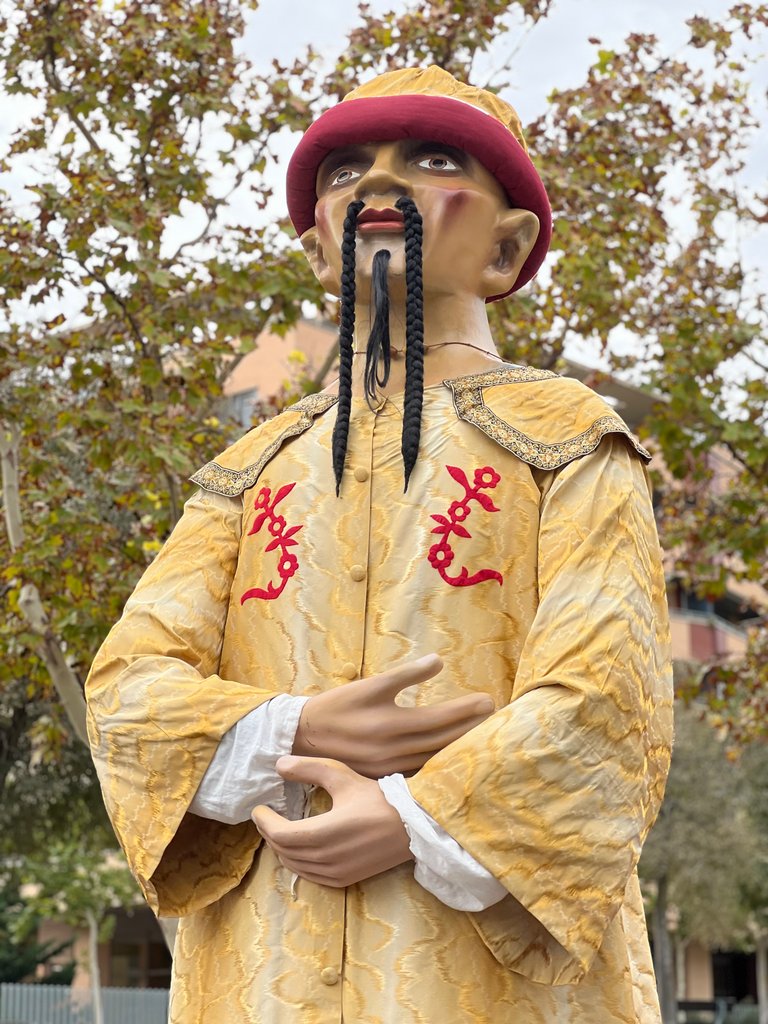

Hola querido hiver.
En Zaragoza contamos con unos personajes especiales que hacen la delicia de grandes y pequeños. Se trata de los componentes de la comparsa de gigantes y cabezudos, unas figuras de cartón piedra que en ciertas festividades salen a recorrer nuestras calles inundándolas de alegría y diversión.
En las pasadas fiestas del Pilar tuve la oportunidad de acercarme a uno de esos recorridos y accedí al lugar de su salida un rato antes para tomarles fotos a placer.
Esta publicación está dedicada a los gigantes y en otra futura te mostraré a sus compañeros los cabezudos.
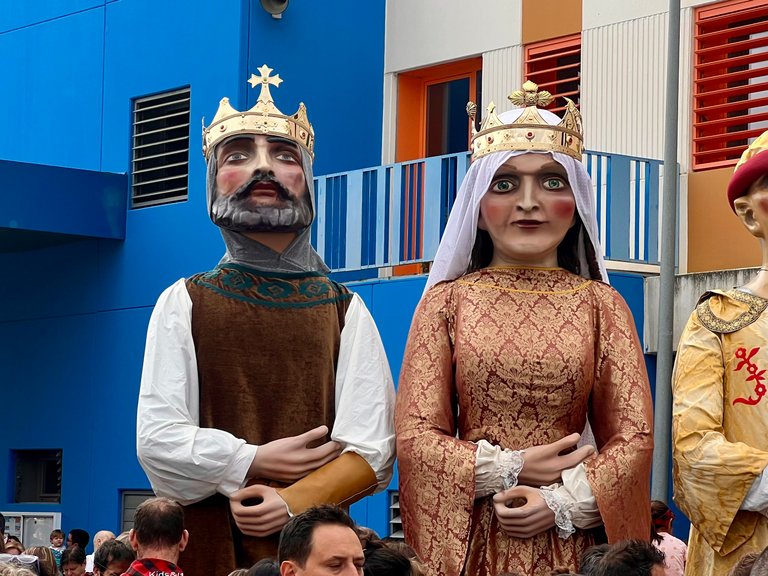
Los gigantes son 14 en total y van en parejas. Siempre se colocan en el mismo orden de más antiguos a más nuevos y así es como los veremos aquí.
La primera pareja la conforman el Rey y la Reina. Gracias a documentarme para escribir esta publicación he descubierto que la figura del rey se asociaba con Jaime I el Conquistador hasta principios del siglo pasado y que ahora se identifica con Alfonso I el Batallador. Este cambio se produjo con motivo del 800 aniversario de la reconquista de la ciudad de Zaragoza por éste último.
A las que nunca se ha puesto nombre es a sus consortes, que aunque hayan cambiado de identidad igualmente hay que bucear profundo en los libros de historia para averiguar cómo se llamaban. Para Jaime I el asunto se complica pues tuvo dos esposas: Leonor de Castilla y Violante de Hungría. Alfonso I por su parte desposó con Urraca de León.

Estos son el Chino y la Mora, que junto a los anteriores formaban la comparsa original, de la que ya se tiene noticias desde el siglo XVII acompañando a la procesión del Corpus. Al parecer se asociaba a cada figura con uno de los continentes conocidos hasta entonces.
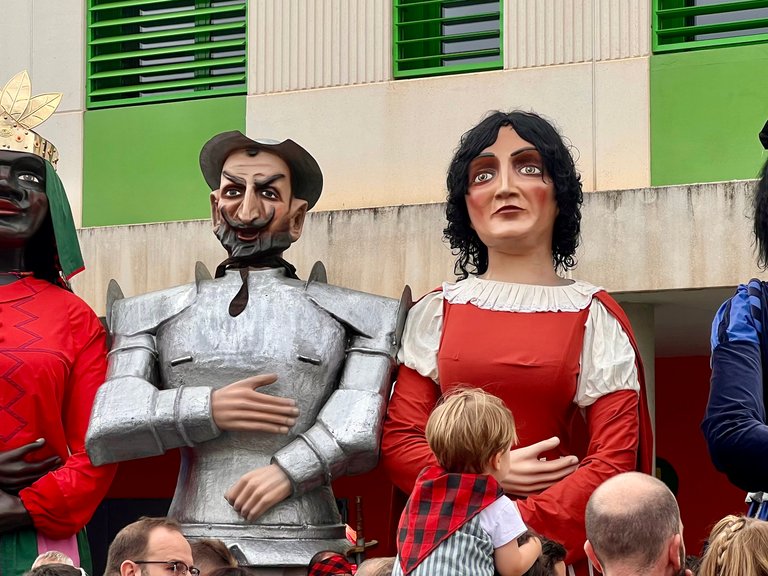
Aquí nos acompañan Don Quijote de la Mancha y Dulcinea del Toboso, personajes de la obra maestra cervantina.
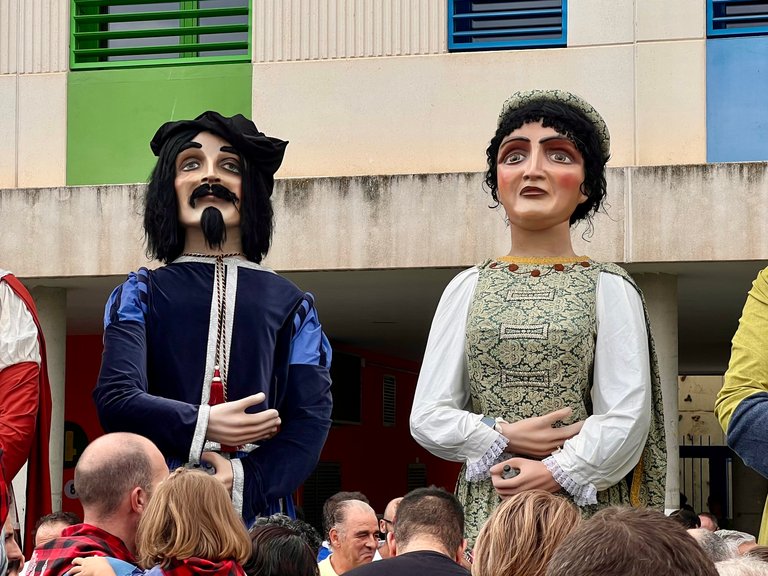
Estos representan a los Duques de Villahermosa, nobles que vivían an Zaragoza y están asociados con los anteriores porque en la segunda parte del Quijote reciben a Sancho Panza en su palacio.

Ya en la segunda mitad del siglo XX se amplía la comparsa con esta pareja para celebrar el hermanamiento de Zaragoza con la ciudad francesa de Pau. El vizconde Gastón de Bearn ayudó a Alfonso I en la Reconquista de Zaragoza. La Dama Bearnesa, su esposa, se llamaba Talesa, y viste el traje típico del Bearn.

En 2008 se celebraron los 200 años de los Sitios de Zaragoza y se presentaron estos dos personajes. Él es José Palafox, el general que se encargó de la defensa de la ciudad. Ella es Agustina de Aragón, una de las heroínas de los Sitios famosa por disparar un cañón que expulsó a las tropas francesas en la zona de El Portillo.
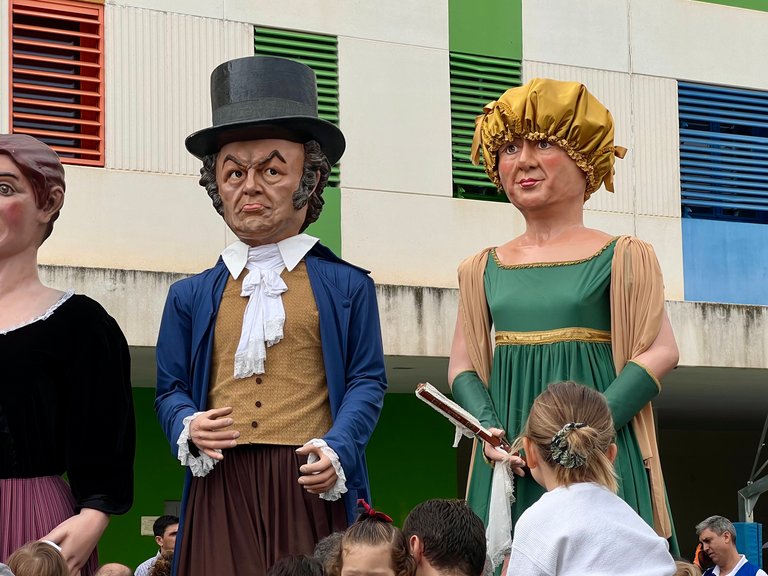
Terminamos con otro personaje universal, en este caso el pintor Francisco de Goya y su esposa Josefa Bayeu. Son los gigantes más nuevos, de 2022.
Aunque los primeros personajes se han ido remodelado con el paso de los años todavía se aprecian las diferencias entre unos y otros, tanto en los rasgos como en las vestiduras.


En estas fotos puedes ver la afluencia de público que arrastran estos personajes. Los gigantes avanzan en fila de uno bailando al son de la ronda que les acompaña.
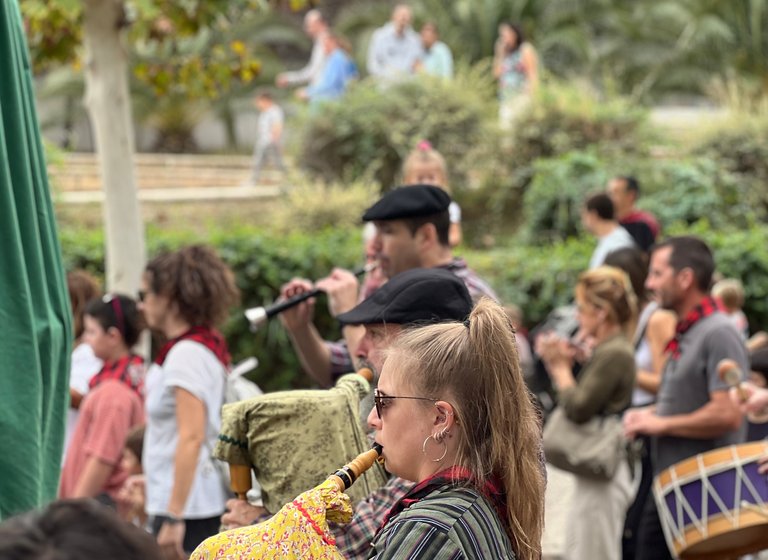
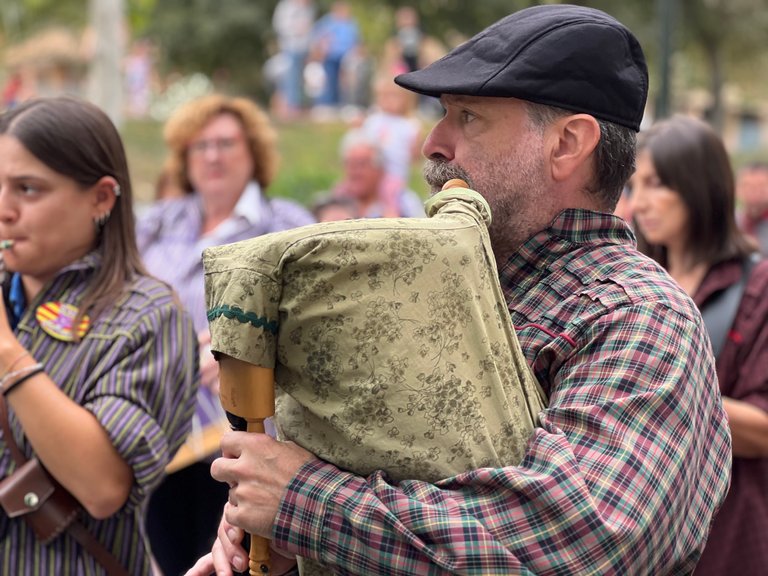
La ronda está formada por instrumentos típicos del folclore aragonés, entre los que destacan las dulzainas y la gaita de boto.

Cada cierto tiempo los portadores de las figuras se detienen a descansar y dan el relevo al compañero que se encarga del siguiente tramo, momento que aproveché para descubrir el interior y romper la magia de los gigantes.
Hasta la próxima publicación. Mientras tanto, ¡cuídate!

Herramientas: Cámara iPhone 13 Pro, editor de fotos Mac.
Si te gusta lo que publico, únete a mi Fanbase pinchando aquí

©️Copyright 2024 Paloma Peña Pérez. Todos los derechos reservados.



Hi, dear hiver.
In Zaragoza we have some special characters that delight young and old alike. These are the members of the comparsa of giants and big-heads, papier-mâché figures that on certain festivities go out to walk through our streets, flooding them with joy and fun.
In the past celebrations of the Pilar I had the opportunity to approach one of those routes and I acceded to the place of its exit a while before to take photos to them to pleasure.
This publication is dedicated to the giants and in another future I will show you their companions the big-heads.

There are 14 giants in total and they go in pairs. They are always placed in the same order from oldest to newest and this is how we will see them here.
The first pair is the King and Queen. Thanks to my research for this publication, I have discovered that the figure of the King was associated with James I the Conqueror until the beginning of the last century and that now it is identified with Alfonso I the Battler. This change occurred on the occasion of the 800th anniversary of the reconquest of the city of Saragossa by the latter.
Those who have never been given names are his consorts, who, although they have changed their identity, still have to dive deep into the history books to find out what they were called. For James I the matter is more complicated as he had two wives: Eleanor of Castile and Violante of Hungary. Alfonso I married Urraca of León.

These are the Chino and the Mora, who together with the previous ones formed the original comparsa, which has been known since the 17th century, accompanying the Corpus Christi procession. It seems that each figure was associated with one of the continents known at the time.

Here we are accompanied by Don Quixote de la Mancha and Dulcinea del Toboso, characters from Cervantes' masterpiece.

They represent the Dukes of Villahermosa, noblemen who lived in Zaragoza and are associated with the previous ones because in the second part of Don Quixote they receive Sancho Panza in their palace.

In the second half of the 20th century, the comparsa was extended with this couple to celebrate the twinning of Saragossa with the French city of Pau. Viscount Gaston de Bearn helped Alfonso I in the Reconquest of Saragossa. The Lady Bearnesa, his wife, was called Talesa, and wore the typical costume of Bearn.

In 2008 the 200th anniversary of the Sieges of Saragossa was celebrated and these two characters were presented. He is José Palafox, the general who was in charge of the defence of the city. She is Agustina de Aragón, one of the heroines of the Sieges, famous for firing a cannon that expelled the French troops in the area of El Portillo.

We finish with another universal figure, in this case the painter Francisco de Goya and his wife Josefa Bayeu. They are the newest giants, from 2022.
Although the first characters have been remodelled over the years, the differences between them can still be seen, both in their features and in their clothing.


In these photos you can see the crowds that these characters attract. The giants advance in single file, dancing to the sound of the accompanying round.


The "ronda" is made up of typical instruments of Aragonese folklore, among which the dulzainas and the bagpipes stand out.

Every so often the bearers of the figures stop to rest and give way to their companion who takes over the next section, a moment I took advantage of to discover the interior and break the magic of the giants.
Until the next post. In the meantime, take care!

Tools: iPhone 13 Pro camera, Mac photo editor.
Translated with DeepL
If you like my content, join my Fanbase clicking here

©️Copyright 2024 Paloma Peña Pérez. All rights reserved.



Que chevere! Creo que he visto estos en tele alguna vez. Debe ser muy entretenido!
!DHEDGE
!BBH
@palomap3! Your Content Is Awesome so I just sent 1 $BBH (Bitcoin Backed Hive) to your account on behalf of @thebighigg. (15/50)
¡Lo es! Los pequeños lo pasan en grande, es genial disfrutar del ambiente de alegría que transmiten los niños. 😃
Hello palomap how are you looks like you love to see them and enjoy a lot.
Yes, it’s a fun parade and I am happy seeing children enjoying with them. 😃
Que belleza de personajes.. que linda tradición aún viva..Y las cabezas de los personajes de que material están hechas??? Madera??
Sí, este tipo de costumbres son muy bonitas y hay que conservarlas para que no se pierdan. Los niños tienen la misma ilusión por ellos que las que tuvimos los niños de las generaciones anteriores. Me parece un tesoro a salvaguardar.
En cuanto al material, son de cartón piedra o papel maché, aunque los más modernos es posible que sean de fibra de vidrio.
Gracias por visitar y apreciar mi publicación, un abrazo. 🤗
Saludos cordiales. Que bonitos y pintorescos personajes, encantó la fiesta y conocerlos. Aquí en Cuba en mi niñez habían personajes similares por tamaño y colorido pero no representaban a alguien en específico, le llamamos muñecones y a mí me asustaban mucho. Gracias por compartir
A mí también me daban un poco de miedo al verlos tan grandes, jajaja, pero como solo desfilan y dan vueltas bailando en seguida pasas a admirarlos. 😁
Muchas gracias por tu visita, un abrazo. 🤗
This looks fun. Thanks for the explanations I found it fascinating.
Yes, children are very happy with them! 😁 I am glad you liked it. 🤗
!PIZZA
¡Qué me iba a imaginar yo que conocería a tan ilustres personajes aquí! 😅
Buenísimo. Siempre me gusta saber acerca de las costumbres zaragozanas. Este carnaval es muy pintoresco. Ay, a mí me encanta la gaita.
Cuida que la gaita aquí puede ser otra cosa además de instrumento musical, jeje. 😜
Las costumbres populares me encantan, me parecen un patrimonio de valor incalculable. En Zaragoza hay un filón de cosas de este tipo para compartir, poco a poco voy inmortalizándolas aquí. 🤗
¿Ruidosas? 😅
View more
Admirable historia y cultura tenéis. En lo personal, el Quijote me encantó, pero es muy fácil reconocer que todos son históricos y su vida debe haber estado llena de datos y de importancia entrelazada una con otra. Me encantaría saber más de historia, pero igualmente no es necesario para poder apreciar a los gigantes. Gracias por compartirlo, me encantó !
Bueno, en todos los lugares se encuentra historia y cultura que aprender. A mí también me encanta conocer estas costumbres, me siento como conectada con las generaciones anteriores.
Muchas gracias por tu visita y por dejar este bonito comentario. ❤️🤗
Buenas noches, estaba viendo este post y realmente es impresionante como hacen esas figuras de cartón con tan buen acabado. Son unos artistas los que lo realizan y se ve mucha alegría en esa tradición y esa cantidad de personas que se reúnen en esta comparsa. La cultura es el pilar de un país, es como me dice un amigo parte de la higiene mental. !Saludos.
Coincido con tu amigo. La cultura es un patrimonio de valor incalculable, pues cuando una tradición se pierde es como si perdiéramos un pedazo de nuestra identidad.
Esta comparsa tiene verdaderos fanáticos que los siguen por todos los lugares donde desfilan. Es increíble la pasión que despierta en algunos niños. 😃
This post was curated by the Visual Shots Team
Join to our Discord Channel
Be part of our Curation Trail
| 25 HP | 50 HP | 100 HP | 200 HP | 500 HP | 1000 HP |
Thank you! 🙏
Realmente interesante
Gracias. 🙂
Gracias a ti
!ALIVE
@palomap3! You Are Alive so I just staked 0.1 $ALIVE to your account on behalf of @ memess. (7/10)
The tip has been paid for by the We Are Alive Tribe through the earnings on @alive.chat, feel free to swing by our daily chat any time you want, plus you can win Hive Power (2x 50 HP) and Alive Power (2x 500 AP) delegations (4 weeks), and Ecency Points (4x 50 EP), in our chat every day.

Thank you! 🙏
Thanks for the support, much appreciated. ❤️
$PIZZA slices delivered:
@sacra97(5/15) tipped @palomap3
This post has been selected for upvote from our token accounts by @thebighigg! Based on your tags you received upvotes from the following account(s):
- @dhedge.bonus
- @dhedge.bee
- @dhedge.pob
@thebighigg has 8 vote calls left today.
Hold 10 or more DHEDGE to unlock daily dividends. Hold 100 or more DHEDGE to unlock thread votes. Calling in our curation accounts currently has a minimum holding requirement of 100 DHEDGE. The more DHEDGE you hold, the higher upvote you can call in. Buy DHEDGE on Tribaldex or earn some daily by joining one of our many delegation pools at app.dhedge.cc.
You can check out this post and your own profile on the map. Be part of the Worldmappin Community and join our Discord Channel to get in touch with other travelers, ask questions or just be updated on our latest features.